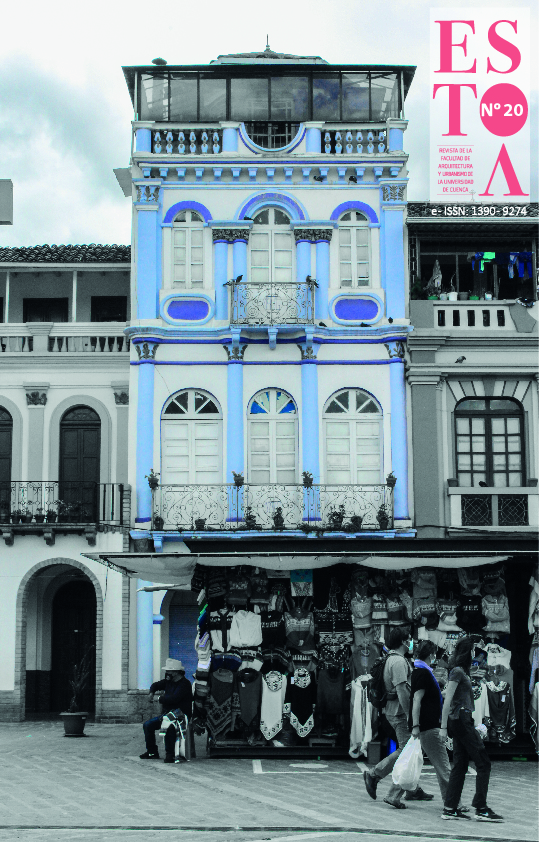From the farms of the Jura to the valley of M’Zab. Influences of the vernacular in Le Corbusier
DOI:
https://doi.org/10.18537/est.v009.n020.a07Keywords:
Le Corbusier, vernacular architecture, modern architecture, avant-garde, traditionAbstract
Le Corbusier’s attraction to vernacular architecture can be seen in his early drawings of the rural landscape of the Jura, when he was still a child, as well as in his drawings of the houses in the M’Zab valley prior to the presentation of the Plan Obus for Algiers. His special predilection for residing in old farmhouses in La Chaux-de-Fonds or the notes in his travel notebooks about the Cubism he recognised in the humble dwellings of southern Spain are snapshots of the Swiss architect’s much deeper experience of the vernacular. The aim of the research is to determine the role played by the vernacular in Le Corbusier’s thought and work from the 1910s to the 1930s projects. The research establishes the vernacular as a determining aspect in his training and attributes to it the shaping of an own architectural language from the 1910s to the projects of the 1930s. The vernacular shows continuity in his personal evolution, identifying four stages with differences of nuance (regionalism, openness to new languages, purism, brutalism).
Downloads
References
Baker, G. H. (1996). Le Corbusier: The Creative Search. John Wiley & Sons Inc.
Benton, T. (1987). Le ‘rêve virgilien’ et la Villa Savoye. En Le Corbusier et la Mediterranée, catàleg de l’exposició a Marsella. Parenthèses.
Brooks, H. A. (1997). Le Corbusier’s formative years. Charles-Edouard Jeanneret at La Chaux-de-Fonds. University of Chicago Press.
Calatrava, J. (2012). Referentes literarios en el pensamiento de Le Corbusier. En Le Corbusier, mise au point. General de Ediciones de Arquitectura.
Çelik, Z. (1992). Le Corbusier, Orientalism, Colonialism. Assemblage (17), 58-77.
Daza Caicedo, R. (2015). Tras el viaje de Oriente. CharlesÉdouard Jeanneret - Le Corbusier. Fundación Caja de Arquitectos (Arquia).
Dumont, M-J. (Ed.). (2006). Le Corbusier. Lettres à Charles L’Eplattenier. Éditions du Linteau. Fondation Le Corbusier.
Gresleri, G. (1987). Les lecons du voyage d’Orient. En Le Corbusier et la Mediterranée: catàleg de l’exposició a Marsella, Centre de la Vieille Charité, juny-set 1987 (pp. 37-50). Parenthèses.
Gresleri, G. (2002). The Balkans. En E. v. Moos y A. Rüegg (Eds.), Le Corbusier before Le Corbusier, applied arts, architecture, painting, photography, 1907-1922 exhibition. Yale University Press.
Jung, F. (1966). Le Corbusier et la ‘Maison du Diable.’ L’Impartial, (15).
Le Corbusier. (1923). Pedagogie. L’Esprit Nouveau, (19).
Le Corbusier y Jeanneret. P. (1929). Le Corbusier et Pierre Jeanneret: oeuvre complète 1910-1929. Birkhäuser Publishers.
Le Corbusier. (1931). Vers la ‘Ville Radieuse’. Une nouvelle ville remplace une ancienne ville. Plans, (8).
Le Corbusier. (1933). Quel rôle Joue L’Esprit Poétique...? L’Architecture d’Aujourd’hui, (10), 63-64.
Le Corbusier y Jeanneret, P. (1934). Le Corbusier et Pierre Jeanneret: oeuvre complète 1929-1934. Birkhäuser Publishers.
Le Corbusier. (1935). La ville radieuse: éléments d’une doctrine d’urbanisme pour l’équipement de la civilisation machiniste. Vincent Fréal et Cie.
Le Corbusier. (1941). Le folklore est l’expression fleurie des traditions. Voici la France de ce mois, (16), 31-32.
Le Corbusier. (1957). Entretien avec les étudiants des écoles d’architecture.. (Trabajo original publicado en 1943). Minuit.
Le Corbusier. (1972). Por las cuatro rutas. (Trabajo original publicado en 1941). Gustavo Gili.
Le Corbusier. (1978). Hacia una arquitectura. (1ª ed. en 1923, Vers une architecture). Poseidon.
Le Corbusier. (1989). Une maison-un palais “a la recherche d’une unité architecturale”. (1ª ed. en 1928). Connivences.
Le Corbusier. (1993). El viaje de Oriente. (1ª ed. en 1966). Colegio oficial de Aparejadores y Arquitectos técnicos de Murcia.
Le Corbusier. (1999). Precisiones respecto a un estado actual de la arquitectura y el urbanismo. (Trabajo original publicado en 1930). Ed. Apóstrofe.
Lejeune, J. F. y Sabatino, M. (Eds.). (2010). Modern architecture and the Mediterranean, vernacular dialogues and contested identities. Routledge.
Martínez de Guereñu, L. (2005). A Vernacular Mechanism for Poetic Reactions: The Villa Mandrot in Le Pradet. En Massilia: Anuario de Estudios Lecorbusierianos (pp. 56-77). Associacio d’idees, Centre d’Investigacions Estétiques.
Passanti, F. (1997). The Vernacular, Modernism, and Le Corbusier. Journal of the Society of Architectural Historians, 56 (4), 438-451.
Passanti, F. (2002). Architecture: Proportion, Classicism and other Issues. En E. Moos y A. Rüegg (Eds.), Le Corbusier before Le Corbusier, applied arts, architecture, painting, photography, 1907-1922 exhibition, Yale University Press.
Pauly, D. (Ed). (1987). Le Corbusier et la Mediterranée, catàleg de l’exposició a Marsella, Parenthèses.
Schubert, L. (2002). Jeanneret, the City, and Photography. En E. Moos y A. Rüegg (Eds.), Le Corbusier before Le Corbusier, applied arts, architecture, painting, photography, 1907-1922 exhibition (pp. 55-68). Yale University Press.
Vogt, A. M. (1998). Le Corbusier the noble savage: Toward archaeology of modernism. The MIT Press.
Zaknic, I. (2017). Le Corbusier, history and tradition. En A. Rabaca et al. (Ed.), August Klipstein’s Orient-Reise, companion to Le Corbusier’s Journey to the East, 1911, Coimbra.
Published
How to Cite
Issue
Section
License
Copyright (c) 2021 Estoa. Revista de la Facultad de Arquitectura y Urbanismo

This work is licensed under a Creative Commons Attribution-NonCommercial-ShareAlike 4.0 International License.
The Journal declines any responsibility for possible conflicts derived from the authorship of the works that are published in it.
The University of Cuenca in Ecuador conserves the patrimonial rights (copyright) of the published works and will favor the reuse of the same ones, these can be: copy, use, diffuse, transmit and expose publicly.
Unless otherwise indicated, all contents of the electronic edition are distributed under a Creative Commons Attribution-NonCommercial-ShareAlike 4.0 International License.




